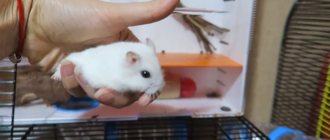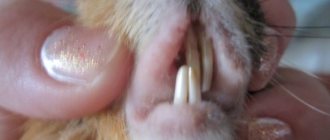These include: spaces under furniture and cabinets, various drawers and shelves, boxes, backpacks, bags, boots, bottoms and backs of electrical appliances that have cavities.
If the hamster is not in any of the secret places, you can follow its travels using bait. To do this, sprinkle a handful of sunflower seeds on the floor and a little flour or cornstarch around it. The animal, having feasted on the bait, will run away to its hiding place, leaving it on the floor, from which it will not be difficult to calculate its location.
You can scatter pieces of foil or cellophane next to the bait. Having done this, you need to turn off the light and wait for the animal to appear, carefully listening to every rustle coming from the bait.
If the hamster has been at home for quite a long time and has managed to get used not only to the hands and voice of the owner, but also to its nickname, the likelihood of quickly catching it increases greatly. The owner just needs to call the animal by name, for example, “Filka, Filka, Filka.” There is a good chance that a happy hamster will come out of its hiding place and return to its burrow.
To catch a hamster in an apartment, you can use a special safe trap for rodents, which is a box that lures the animal but does not kill it. It is usually called the “live mouse trap.”
There is another effective way to catch an escaped hamster. At the bottom of a three-liter jar or other tall vessel with slippery edges, you need to place some kind of delicacy that has a fairly pronounced smell. In front of the jar on the floor, you should build a hill, for example, from books or magazines, resembling a ladder. That's where you need to put a trap. All this is done, naturally, for the convenience of the hamster’s penetration into the jar. A hungry animal will crawl through books and magazines, go down to the jar for food, but never get back out.
Some hamsters have a very restless disposition. They are restless, energetic and try to escape from their owner at the first convenient opportunity. If the hamster has escaped, you need to urgently start searching for it. After all, invisible dangers may lie in wait for the animal outside the cage. Therefore, every owner should know where a pet can hide and how to catch a hamster.
Why did the hamster run away?
The leaders in terms of escaping are the dwarfs; they are nimble, nimble and inquisitive. Owners of Syrian hamsters are also not immune to escapes, although they occur much less frequently. First of all, we need to figure out why the pet ran away and got lost. This information will help prevent future escapes.
The reasons for the flight of a furry creature may be as follows:
- Unreliable cage. The hamster cannot escape from the cage if all the bars are intact and the locking mechanism is working properly. But sometimes the little sly ones manage to gnaw a hole in their apartment and escape outside.
- The instinct of self-preservation. Having sensed a cat or other dangerous animal, the homa instinctively strives to get away.
- Fear. A small creature may be frightened by a sharp sound (clap, vacuum cleaner, scream, bark, etc.).
- Curiosity. There are fluffies who love to explore the world. Once in a new place, they want to know more about it.
- Fatigue. If Homa hasn’t gotten enough sleep, is in a bad mood, and you forcibly pulled him out of his cage to play, then rest assured: he will sneak away at the first opportunity and hide somewhere where he will be left alone.
- Inattention of the owners. The most common cause of hamster escapes. This is especially true for children, who often forget that rodents cannot be left unattended!
Try to avoid inattention and monitor the condition of the cage.
Reaction to escape
When a tiny creature escapes, the owners' reaction is often inadequate. Some start running and screaming, scolding the children loudly. Others, on the contrary, let the situation take its course in the hope that the pet will get some exercise and return. This attitude is fraught with the death of the animal: it can get caught by a cat, jump into a closing door or under your feet, and ultimately get stuck somewhere and die of thirst and hunger.
How to behave correctly and what to do if a hamster runs away? First of all, you need to remember Carlson’s advice and remain calm. But you need to start searching immediately. How to find an escaped hamster in a small apartment if he has been living with you for a long time?
Tamed hamsters know their nickname and sometimes respond to it. Call the baby by name and promise him something tasty. You can lightly shake the jar of his dry food: the animal is familiar with this sound and is attracted to it. There is a small chance that Homa will respond to the nickname and return to the warm hands of his owner.
But if the hamster escaped from the cage and does not want to return home, the search may take a long time. Therefore, it is important to know how to catch an escaped hamster and where it may be hiding.
Search strategy
How to find a hamster in an apartment, using knowledge about some of the habits and habits of these animals? For example, it is known that hamsters are nocturnal animals, that is, at this time their activity increases. If you haven't found it before evening, don't get upset. Most likely, closer to midnight, people will start running around the apartment and then you can quickly notice the loss. But be careful with the rest of the family - don’t accidentally step on the animal.
Use a bait trap. Place a few sunflower seeds in some corners of your home - and the rodent will not keep you waiting. If you don't take him by surprise, you'll at least have a rough idea of where the pet is hiding. Of course, if the loss of seeds is not the work of hungry household members. Or you can be even more cunning - sprinkle the floor around the piles of seeds with flour or starch. Then the white footprints will lead you to the shelter of the lost homa. Another method to find it is to lay foil or other “rustling” material on the floor in the area of the intended hiding places. At night, hide nearby and listen to the surrounding sounds, trying not to make unnecessary movements.
Simple tips on how to find an escaped hamster in an apartment will help you determine its location. But the process of capture itself is also not an easy task. How can you competently deal with it?
Where to look?
You can look for an escaped hamster in an apartment anywhere. Tiny animals can hide in the most inaccessible places. If he escaped before your eyes, you should immediately examine the place where he disappeared. If you don’t find the fluffy one, close the entrance door to the room.
But if there are many rooms in the house, the search task becomes much more complicated. After all, each room will now have to be monitored separately. Most often, fugitives do not leave the room where their cage is located, but there are exceptions. So what to do if the hamster runs away, where to look for your pet?
First of all, inspect the following places:
- Cabinets and other furniture. The hamster may hide behind or under the backs of dressers and cabinets. If he escaped in the bedroom, first look under the bed.
- Carpets, rugs. A frightened animal may well crawl under the rug, especially if it does not fit well to the floor. To avoid crushing the crumbs, it is better to remove the rugs.
- Heat and water supply system. Rodents love warm places, so they are able to hide under the sink or near the radiator.
- Pantry. If you have a pantry at home, then this is a paradise for a rodent. It's always quiet there and there's something to eat. If the furry friend settled down there, the search will last for weeks.
Basically, if a hamster runs away, it could be anywhere. But one thing is certain: small rodents do not jump very high, so you should look for the animal in the lower part of the premises.
Tracking down the fugitive
First of all, let's set priorities: before catching an animal, it must first be detected. Therefore, the question “how to catch an escaped hamster?” replace it with “how to track an animal?”
Methods of tracking a baby can be different. They depend on the size of the room, the number of rooms and the availability of available materials. First, let's figure out how to catch a hamster in an apartment with several rooms. You can determine the location of a rodent in different ways:
- attract food. Treats should be left in the hallway, each room and kitchen overnight, and all doors should be closed tightly. Carry out an audit the next day. Where the grains disappear (or are scattered), there the homa hides;
- listen. The hamster can gnaw grains, squeak quietly or rustle its claws on the linoleum. Hide, turn off the lights and listen. It is advisable to turn off noisy electrical appliances;
- look around. You may notice rodent feces.
When you figure out the room in which your pet is hiding, find out which side of the room he is hiding in. To do this, add the grains again, and rub a thin layer of flour around them. In the morning you will definitely see a chain of tiny footprints leading to the homa’s shelter.
Proper nutrition
There is a wide variety of food for rodents on display at pet stores. However, despite what the labels say, not all of them are created equal. Cheap food is not suitable for feeding hamsters - they are usually of poor quality, incorrectly balanced, and do not contain all the necessary substances and vitamins. There have been cases where rodent poison was found in food, which caused the death of pets.
For normal functioning, hamsters need balanced dry food. It should include cereals, plant seeds, herbs and flowers, as well as protein supplements in the form of dried insects.
It is important to give hamsters allowed vegetables and fruits. You can feed hamsters cucumber, zucchini, broccoli, cauliflower, lettuce, turnips, radish
Types of hamsters that are not predisposed to diabetes can be given pumpkin, carrots, fruits and dried fruits.
It is forbidden to give onions, white cabbage, sorrel.
How to catch a hamster in an apartment?
The easiest way to catch a rodent is to pour out treats and wait for the pet to come to eat. If the trick worked, you need to quietly approach the fluffy and cover it with a light cloth napkin, this will prevent him from going on the run again.
Carefully! You must approach quietly and quietly so as not to scare the animal!
This technique does not always work. Sometimes it takes too long to wait for the hamster, but you have urgent matters. Or the animal may hoard food and ignore treats. What to do in this situation? There are a few other clever tricks you can use if your hamster has escaped from its cage.
The cell is the home
Perhaps your pet already misses his cozy home, but does not dare to go out. Try placing his cage in the center of the room at night with the door open and a ladder along which he can get inside. Hang up a drinking bowl with fresh water in advance and fill the animal’s bowl with its favorite treat.
You can put pieces of food on the steps of the ladder so that the homa will definitely find his way. There is a chance that by morning the pet will return to its native land.
Favorite toy
It is possible to attract a fluffy's attention with attractions. What is hamsters' favorite toy? Of course, the wheel! Set up the attraction in the room where the animal is hiding. If you hear familiar sounds, immediately go to catch the rodent.
Traps
It happens that all of the above actions did not lead to the capture of the fugitive. Then you will need a hamster trap that is easy to make with your own hands. The trap will help both lure the hamster out from under the closet and keep him in. Don’t be alarmed, this device is very humane and will not harm your pet.
Trap tube
If the animal is hiding under a closet or bed, you can catch it with a snorkel. The snorkel is most often used to catch a rodent that is not used to being handled. Don't know how to make a hamster trap? Everything is very simple:
- Take a paper towel roll.
- At one end attach a fragrant treat.
- Seal the tube on the bait side.
- Point the open end towards where the hamster is hiding.
When the homa comes to eat, cover the entrance with your palm and transfer the trap tube into the cage. Lift the sleeve carefully so as not to scare the fluffy one!
You can catch a small animal using a plastic bottle trap. It is most convenient to make a device from a 2-liter bottle with flat walls (so that the trap does not swing in different directions).
Cut off the bottom on three sides, leaving the fourth intact. Bend it up and secure it in this position with an elastic band. In this trap, the door will not slam shut; air must flow through the entrance. Attach a bridge to the bottom edge of the bottle so that it goes up inside the bottle and bends slightly under the weight of the tiny creature. The center of the bridge should be rubbed with a nut, and the treat itself should be placed inside the bottle.
The hamster, sensing the aroma, will go into the bottle, chew the treat, but will not be able to jump back onto the bridge. This is where you catch the animal!
Bucket trap
Usually, they try to catch rodent pests using a bucket by pouring water into the bottom. We don’t want to cause harm to the funny little animal, so we line the bottom with a thick layer of sawdust or hay so that the hamster doesn’t hurt himself when he falls.
So here are the instructions:
- take a bucket, pour a shockproof layer of bedding inside;
- cover the trap with a sheet of paper;
- place a treat on top.
- attach a “ladder” to the bucket (ruler, ladder made from books, etc.);
- Place a seed on every 2-3 steps.
The fluffy miracle, making its way up the stairs, realizes that there is something tasty at the top. Seeing the bait, the pet will stand on the paper and fall into a bucket on a soft bedding, where it will wait for the owner. The little animal will not be able to get out of the bucket because of the high edges.
Gastrointestinal diseases
There are various diseases of hamsters that are caused by pathogenic microorganisms. Among them, veterinarians identify pathologies of the digestive tract. They cause gastrointestinal disorders, and in severe cases can lead to the death of the animal.
Worms are also common in hamsters, which enter the body along with contaminated food or water. The disease can be determined by the slow growth of young animals, sudden weight loss (with normal nutrition), problems with fur (for example, oily sheen)
It is also worth paying attention to the consistency of the stool: it becomes soft, the mass contains blood, mucus or fragments of parasites
Colibacillosis
This disease in hamsters is caused by E. coli. Colibacillosis is also called “wet tail”. This is because loose stools cause the fur around the hamster's anus to be wet.
The disease occurs as a result of the penetration of E. coli into the body. The source of infection is contaminated food or water.
You can tell that your hamster has colibacillosis by the following symptoms:
- watery diarrhea with a pungent odor;
- decrease or disappearance of appetite;
- weight loss;
- anxiety;
- depression, lethargy, apathetic state;
- exhaustion of the body;
- sometimes high temperature;
- uncertain movements;
- increased heart rate and breathing.
Specific signs of colibacellosis are loose stools and wet fur around the anus. The hamster is constantly trying to find a secluded place and curl up into a ball. He looks sloppy, his fur is disheveled, his ears are flattened, he doesn't move much.
The disease develops quickly, so treatment must be started in the early stages. Therapy is carried out under the supervision of the attending physician. The infection should be treated with electrolyte solutions and antibiotics (tetracyclines are often used). The former improve the hydration process, while the latter destroy bacteria in the intestines.
Therapy is carried out at home. During the treatment period, you must follow the diet prescribed by the ratologist.
Escherichia coli
Hamster diseases caused by E. coli can lead to the death of the pet. The infection begins to develop after a pathogenic microorganism enters the animal’s body, which begins to multiply rapidly. Because of this, the natural intestinal microflora changes, and the hamster’s condition deteriorates sharply.
Signs of an illness caused by E. coli:
- high body temperature;
- diarrhea with blood streaks;
- weakness, apathy;
- the animal does not eat anything;
- weight loss;
- blanching of the mucous membranes.
The infection progresses quickly and often ends in the death of the animal. To prevent this from happening, when the first symptoms of the disease appear, you need to contact a ratologist. The doctor will prescribe a bacteriological analysis to identify the pathogen and develop treatment tactics. Intestinal antiseptics and antibiotics will help destroy the source of infection.
You can get E. coli from a sick hamster. To avoid this, a person should thoroughly wash their hands with soap after contact with the animal. To prevent illness, you should keep your home clean.
Enteritis
This is a disease in which the inflammatory process affects the small intestine (some parts or all of it). As a result, its functionality is impaired, and dystrophic changes appear on the mucous membrane. Then various digestive disorders arise.
The main reason for the development of enteritis in a hamster is considered to be the lack of hay in its diet. The disease is manifested by increased gas formation in the intestines and diarrhea.
Enteritis is treated by introducing high quality hay into the hamster's diet. Specific therapy is also carried out: the feces of a healthy animal are diluted with water, and then administered through an enema into the patient’s intestines.
Prevention of escapes
If your hamster often runs away, you need to think about the reasons for this phenomenon. To stop the escapes, follow these recommendations:
- Strengthen the cage. You should patch holes that animals have gnawed and check the reliability of the door. By the way, the door can be kept closed using a clothespin.
- Create a calm environment for your pet. If there is a stereo system, TV and other noisy devices next to the cage, then the Homa runs away from the house precisely because of them. Move the rodent's house to a place where it cannot be reached by loud noises or other pets.
- Don't break your daily routine. If you see that the fluffy is not in the mood for communication and wants to sleep, do not force him to play, otherwise he will try to run away.
- Do not leave the animal alone outside the cage. Follow every step so you don’t have to search and catch later.
These basic tips will help prevent your hamster from escaping and will make his and your life calm and comfortable.
Remember: small rodents rarely escape from a good life. If the hamster runs away, your task is to double your vigilance, quickly catch your pet, check the health of the cage and make sure that the animal lives in peace.
Hamsters are inquisitive and persistent little creatures that love to hide in small spaces and become active while you sleep. In addition to this, they are great escape artists. Therefore, make sure once again that cages, playpens, carrying containers and balls for hamsters do not leave any chance for the little tomboy to escape - the outside world is by no means safe for a hamster. If you find your pet has escaped, here are some tips to help you find and catch your hamster so you can return him to his cage.
Causes caused by incorrect temperature conditions
In order to understand whether the hamster is really sick if he does not move but breathes, it is worth performing a detailed examination
Attention should be drawn to the baby's eyes, breathing rate, and the naturalness of his posture. If your pet is breathing calmly and steadily with his eyes closed, it is most likely that he is just sleeping.
Heatstroke
It is known that individuals of the order of the hamster family, without exception, cannot tolerate heat or direct sunlight. Oddly enough, nature has deprived them of a system of protection against overheating; pets never sweat or breathe through their mouths like dogs. There are known cases where heat stroke resulted in death for animals.
To understand that your baby is overheated when he lies on his side and breathes heavily, you should pay attention to the presence of such signs as:
- no attempt to roll over or make any movements;
- lethargy;
- presence of seizures;
- impaired coordination of movements.
The likelihood of heatstroke occurring when your hamster is motionless and panting increases under the following conditions:
- improper transportation of the baby in personal transport;
- installing the cage on a balcony, window sill, in a place exposed to direct sunlight;
- installing the cage near heating devices;
- with high room humidity and stuffiness.
If you don’t immediately help your pet when he doesn’t move but is breathing, he may not be saved. For this reason, it is worth providing first aid to the animal, which is to:
- cool his body temperature - put the baby on a damp towel, tile, moisten his ears and paws with cool water. Do not rub frozen ice cubes or place them in water;
- inject subcutaneously 2 ml of water that the animal usually drinks to prevent dehydration;
- carry out anti-shock therapy - without waiting for the doctor, this should not be done. But if the ratologist is delayed, and the pet is getting worse, he can be given an injection in the hind leg (intramuscularly) of prednisolone 30 mg/ml with a syringe intended for administering insulin. The dose for a Syrian will be 0.1 ml, and for a Djungarian - 0.5 ml.
"Coma" or hibernation
If the hamster lies without moving, it is possible that the pet has fallen into a kind of coma, that is, into hibernation. His breathing remains calm and even, and his skin will be somewhat cool. In the wild, hibernation of individuals of the hamster order usually occurs in the winter season, when they need to survive cold, hunger, and decreased daylight hours.
The causes of “coma” can be the lack of food for several days in the absence of its strategic reserves, a heating shutdown or a sharp cold snap, which makes the apartment cool. The main signs that the baby is hibernating will be:
- closed eyes while breathing;
- cold but soft to the touch body;
- slow heartbeat (no more than a beat every 15 seconds).
In such cases, it is recommended to place the animal’s cage in a room where the temperature is equal to or above 20°C, and fill its feeder and drinking bowl. Within a few days, if all is well, the animal usually wakes up. If, after emerging from hibernation, he has impaired coordination of movement, which does not go away, he begins to sneeze, cough, or develops diarrhea, as evidenced by a wet tail, you should consult a veterinarian. And since it is undesirable to transport the baby after waking up from hibernation, it is better if he arrives on his own.
"Help! My hamster has escaped!” - first steps
First of all, don't panic! When you see an empty cage or container, do not shout or fuss. Keep calm and sober mind. This will help catch the hamster easier and faster, as loud noises will scare him away.
As soon as you realize that your hamster has escaped, immediately close the room door to prevent him from leaving the room. This will make the search process easier - it is much easier to search in one room than in the whole house. Inform everyone at home that the door to the room is closed. This is especially important if you have other animals in the house that could harm your hamster, such as dogs or cats.
Feed
So how to catch a hamster in the house? If you don’t know which room the rodent is in, then pour a handful of grain into each room and leave it overnight. Place food near baseboards. The rodent will most likely find it there.
Once you have figured out where the hamster is, sprinkle handfuls of food throughout the area. This way you can understand in which part of the room the hamster lives. Thanks to this, you will be able to significantly reduce the search area.
Once you have determined which room the hamster is in, it is advisable that no one else enters it until you catch the rodent. Otherwise, there is a risk that someone will accidentally injure or step on the animal.
To catch a hamster, you need to find it
If you see an escaped hamster peeking out from its hiding place, stay as quiet as possible and try not to make sudden movements. Make a dark, cozy place for your hamster that he can unexpectedly stumble upon and hide in. A long cardboard tube or box is suitable for these purposes. A resistant hamster can be lured into a trap with a treat. Place your pet's favorite food at the far end of the box (tube), hamsters usually easily enter a dark space (especially if there is a treat waiting for them there), and you can close the entrance. The escaped hamster has been caught! Then carry it without removing it from the trap and place it back in its cage.
Trying to catch an escaped hamster by running and waving your arms or things is not only useless, but also funny. Just imagine how funny it is to see an adult with a colander in his hands trying to catch a small harmless animal. This act is worthy of a circus arena! Of course, this approach will not work, but on the contrary, it will only intimidate the hamster even more and then you will have to wait a long time until he calms down and begins to make attempts to crawl out of his shelter.
To find an escaped hamster, you can use the following trick. Place a plate with treats for your hamster in the center of the room. Make a wide ring of flour around the plate. Your fugitive, sensing a treat, will come for it and at the same time smear his paws in flour. A trail of footprints will lead you to your pet's temporary shelter. This option will not suit you if your room has carpet or rugs on the floor.
But here is an option suitable for everyone, how to find an escaped hamster, and maybe even catch it in the process. Leave a paper bag in the center of the room and place a treat for your hamster at the bottom. When a curious fugitive climbs in for a treat, you will hear a loud rustling of paper and can catch the hamster while he is distracted.
How to catch a hamster if you can't see it
If you don't see the hamster and don't know where he is, make sure there is nothing edible left on the floor in the room. All available food should be in traps, so the hamster will have a serious motivation to get into one of them. “Hunger is no help, it won’t bring you a pie” - and hamsters know this. We advise, however, to leave free access to water so that the hamster does not become dehydrated.
Look for the hamster in all obvious dark and cozy places, such as under or behind furniture, under the refrigerator. If you have several hamsters or other rodents in your home, be sure to check their cages - your escapee should not get into any of these cages, as this can lead to serious injuries to your pets.
If, as a result of your searches, you were unable to find your escaped hamster, then it’s time to set traps in the room where your pet may be. Use different types of traps at the same time: humane mousetraps (that do not kill or injure animals) and a container trap. Humane mousetraps are too small for Syrian hamsters, but work well for Chinese hamsters.
Some small hamsters can freely enter and exit humane mouse traps without triggering the trap mechanism, so it is advisable to tilt such devices slightly. You can also use non-grab and run treats, such as baby food.
Don’t forget to leave the entrance to the cage open at night, make a stand from available materials so that the hamster can climb back into it. For this purpose, both books laid out in the form of a staircase and a wooden rail placed under the entrance (a kind of ramp) can be suitable. Leave a nice-smelling treat in the cage itself.
Trap container
A container trap is a box or other suitable container, such as a bucket, with tasty-smelling food, bedding and a drinking bowl at the bottom. Build a ramp (incline) leading to the top of the container, which should be deep enough that the hamster will not be able to get out of it once he gets there. A container trap is an effective means of catching an escaped hamster.
Do not give up
If you do not immediately manage to find and catch the escaped hamster, do not despair - try again a little later. Hamsters are more active at night, so in the late evening or morning you will have a better chance of finding and catching them. Don't give up when the day is over. Continue searching and setting traps. There are cases when the search for hamsters continues for a month or two. Therefore, if the search drags on, do not forget to leave food and water in the room, so your fugitive will have a chance to survive.
What to do after catching an escaped hamster
When you catch your hamster, check its health. Pay special attention to:
- injuries to the legs or back, for example from a fall;
- cuts, bites or wounds, especially on the tummy, face and paws (usually appear after the hamster has approached other cages with rodents);
- signs of dehydration;
- dirt, phlegm or sticky substances in the fur (make sure the hamster is clean and dry before placing it back in the cage).
Before you put it down, make sure you have eliminated any potential escape routes, such as damaged or poorly fitting cage parts. On wire cages it is useful to make latches on the opening parts. Use tape to seal the hamster ball door, as rodents can quickly learn to twist it and run away.
Hamsters are wonderful little pets that don't cause much trouble for their owners. They are kept in cages, terrariums and aquariums. But it may happen that your hamster was somehow able to leave his home.
Finding a fugitive is not easy, but it is quite possible. And now we will tell you how to do this.
Number of teeth
Surely, you will be interested to know how many teeth a hamster has - Djungarian, Syrian and others. It is very difficult to count them yourself, since the rodent, like other animals, does not like it when people look into its mouth. Most people think that a fluffy's mouth consists of a pair of large teeth on the upper and lower jaws.
In fact, the animal has 16 teeth in the oral cavity - the same 4 incisors in front and another 6 lateral molars, which do not stand out at a superficial glance at the animal’s mouth. Their role in the body is very important - with the help of the incisors, the pet grinds, and with the lateral molars, chews all the food before it enters the gastrointestinal tract. To examine, pull the animal by the mane and slightly move the cheek pouches.
Inexperienced owners may be concerned about why their hamster has yellow teeth. Don’t worry, this enamel color is normal for them, and not a sign of any pathology or a consequence of poor nutrition.
The shade of the enamel may change to a darker color when the animal consumes food with a high content of dyes. Give preference to cereals, fresh fruits and vegetables. It is also possible that the darkening is age-related: your pet is simply getting old.
Why can a hamster escape from its cage?
First, let's look at the possible reasons for escaping:
- You forgot to close the cage.
You should not leave the door open unattended, even for a minute; hamsters love freedom very much and can take advantage of such a convenient moment. - Cage with wooden base.
A small animal can gnaw on a tree, causing the rods to become loose, and it can easily crawl out. - Aquarium without a lid.
From such a home, a hamster can very easily be released into the wild. In order to climb up and escape, he will use available means, for example, a running wheel. - While walking around the apartment.
Children usually like to take hamsters for walks, but if a child is distracted for even a moment, his pet will immediately disappear in an unknown direction. - While cleaning the cage.
It is best at such a moment to move the pet into a three-liter jar and give it a treat, otherwise escape is almost inevitable.
Important!
Make sure your hamster's housing is sturdy, especially cages with wooden parts. If the walls are flimsy, then immediately take measures to strengthen the cage or buy a new one.
Article information
This article was co-authored by Pippa Elliott, MRCVS. Dr. Elliott, BVMS, MRCVS is a veterinarian with over 30 years of experience in veterinary surgery and the care of companion animals. She graduated from the University of Glasgow in 1987 with a degree in Veterinary Medicine and Surgery. He has been working at the same animal clinic in his hometown for over 20 years.
This page has been viewed 21,668 times.
Was this article helpful?
Often, owners rush around the apartment with the question, how to find a hamster? Because their favorite animal ran away, opening the door with its paw. But it’s worth knowing that these animals are very smart and agile, then you can take action in time and the hamster will not run away. But if this has happened, it must be found. This will be much easier to do if you know and take into account the peculiarities of his behavior.
Where can hamsters hide?
If your little rodent does escape, then do not panic, but rather start searching right away. Keep in mind that the hamster has found himself in places unfamiliar to him, he is afraid and, most likely, will hide in some quiet place that is safe from his point of view. We recommend that you carefully search in the following places:
- objects near the cage itself (clothes, dishes, books), because maybe the fugitive was hiding very close by;
- behind any furniture where there are any cracks, holes (walls, bedside tables, sofas, tables, chairs, etc.), as well as inside it;
- a variety of boxes and jars of any size;
- bags and shoes;
- household appliances, especially those with holes or crevices;
- secluded places in the bathroom and toilet.
Important!
Be sure to close the toilet lid, remove easily accessible chemicals and other pets, especially cats. All this poses a danger to your pet rodent!
Tracking a fugitive
We follow simple tips:
- Hamsters are nocturnal animals, so you need to catch them in the dark, when they are active.
- Leave some seeds or other treats on the floor of each room - the animal will get hungry and give itself away when starting its meal.
- Sprinkle a little starch or flour around the treats you left for the animal - this is so that the fugitive leaves traces. This way you will understand in which direction the traveler is moving.
- Flour and starch are poured in a similar way along doorways or in front of the animal’s intended shelter.
- To catch the baby, place foil or plastic bags on the floor - the animal’s movements will be accompanied by a rustling sound.
How to catch a fugitive in an apartment
If your search is unsuccessful and the small pet seems to have fallen through the ground, then you will have to be smart and simply track down the escaped animal.
Sprinkle treats
The fugitive will sooner or later want to eat, and hunger will drive him out of the secret place in search of food. Therefore, in every room, kitchen and other areas of your home, place sunflower seeds on the floor (hamsters love them). Keep in mind that you are looking for an animal that is active at night, which means it makes sense to check the edible bookmarks in the morning. Remember the places where the seeds disappeared and the next night add the treat there again. All that's left to do is sprinkle some flour or cornstarch around it. Now you can easily track your pet to his hiding place using tiny white footprints.
Favorite toy
You can use the running wheel that is in the cage. Hamsters usually love to run around in it.
Did you know?
A small hamster, turning the wheel with its tiny paws, can run up to 10 km during the night!
Wait until evening and put your favorite toy on the floor, turn off the light. After a while, you can hear the fugitive running in circles out of habit. All that remains is to remove the animal from the wheel and move it to a permanent place of residence.
Hamster traps
If the simplest methods do not work, then you will have to set traps. They are not at all difficult to make with your own hands. The main thing is that such devices are safe for small furry rodents.
From a plastic bottle
The process of making a trap from a plastic bottle is as follows:
- Take a 2-liter plastic bottle with flat sides.
- Prepare scissors, an elastic band and a small board or thick cardboard.
- Using scissors, cut three sides of the bottle from the bottom, leaving the fourth side alone. The bottom will be the door through which air will flow, so bend it back and secure it with an elastic band so it doesn't close.
- Prepare a so-called bridge according to the size of the bottle, along which the hamster will get inside the trap. Attach the bridge to the lower free edge of the bottle so that it goes inward at a slope and can bend under the weight of the animal.
- Place some tasty bait in the bottle.
- The hamster, smelling a delicious smell, will fall into the bottle along the bridge. Then the bridge will rise back, and the fugitive will fall into a trap.
Toilet paper roll
The next simple device for catching a hamster is a cardboard toilet paper tube (paper towels are also suitable).
But this method is good when you can roughly guess where the pet is hiding. You just have to wait for the animal to enter the trap. So, take the sleeve, seal one of the edges. Place a treat inside and point the free edge to where your fugitive is most likely hiding. Having smelled a tasty smell, the animal will probably walk into an improvised trap. Wait for this moment and carefully, covering the hole with your palm, transfer the hamster into its cage.
Another handy tool for a trap is an ordinary plastic bucket. Be sure to put something soft (towel, hay, sawdust) at the bottom so that your hamster does not break. Now think about the path along which the animal will get into the bucket.
This could be, for example, a ladder made of books or a board. Place the seeds along the way, cover the bucket itself with a sheet of paper, on which put something tasty. The hamster will follow the bait and will inevitably fall into the trap.
How to prevent escape
Catching an escaped hamster is quite a difficult task, so it is best to create conditions for the animal so that escape is minimized.
Did you know?
Hamsters, despite their miniature size, are distinguished by their intelligence: they remember their nickname, recognize their relatives and are capable of training.
- the cage must be strong and reliable; it is best to hang a lock on the door, because the hamster can quickly handle the latch;
- The bottom of the cage is best made of plastic; the hamster most likely will not chew through it;
- It is best to place the hamster’s home in a quiet and peaceful place, loud noises, other pets, a large number of people will disturb the animal, and it can run away at the first opportunity;
- Provide your pet with toys, good food and drink;
- watch your hamster's mood, if he is sad, it means he doesn't like something, play with him.
Now you know how to prevent your pet from escaping. And if this does happen, then following all the above recommendations, finding the missing animal will not be difficult. .
Warnings
- If your hamster moves only on his own, provide him with a container or his walking ball so he can climb inside and you can move him into the cage. Don't grab the hamster. If he is injured, then you can make the situation worse by grabbing the animal. Bring the hamster's walking ball to the cage door and let him move into the cage on his own.
- Be aware that your hamster can be injured (as these animals have very fragile, brittle bones) if it falls from a height of more than 25 cm.
- If your hamster falls from a great height, do not try to pick it up. If the hamster does not move but is breathing, slip a piece of paper under it and place it in the cage. If you are concerned about your hamster's condition, take him to the vet.











